We use insulated horizontal stationary Layens-style hives. The double walls of our long, deep horizontal Layens hives are insulated with 1.5” of raw natural sheep’s wool providing 6 times the insulation value (R6) of conventional hives — ideal for bees’ development and for surviving cold Maine winters. In addition to insulation, natural wool absorbs the excess moisture.
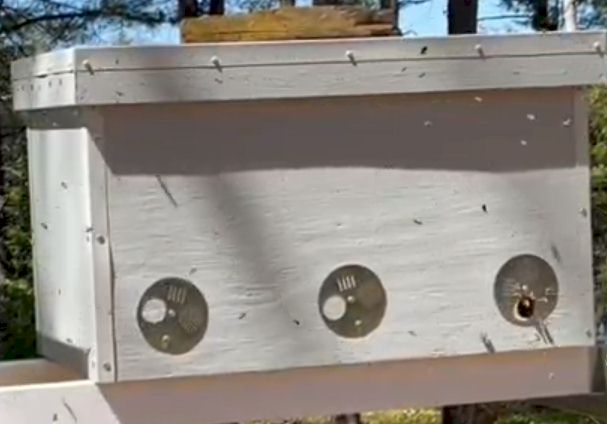
Layens horizontal hives with deep 16″ frames have been in continuous use since the 19th century, as they are easy to manage with minimal disturbances to the bees. These hives are very popular in Spain & France and insulated Layens hives are now gaining popularity in the US especially in areas with cold winters.

Layens Horizontal Hives allow beekeeping with minimum disturbances to the bees
Because the bees in Layens hive don’t have to travel up/down between separate vertically arranged boxes, single deep contiguous Layens hive’s frames were designed to have no honeycomb cracks in-between. This makes it possible to manage the bees in Layens hives with significantly fewer disturbances during inspections than with the conventional Langstroth vertical hives.
When we open the Layens hive’s lid during inspections, no light penetrates the closed combs and we almost never see disturbed bees flying around as with conventional Langstroth hives.
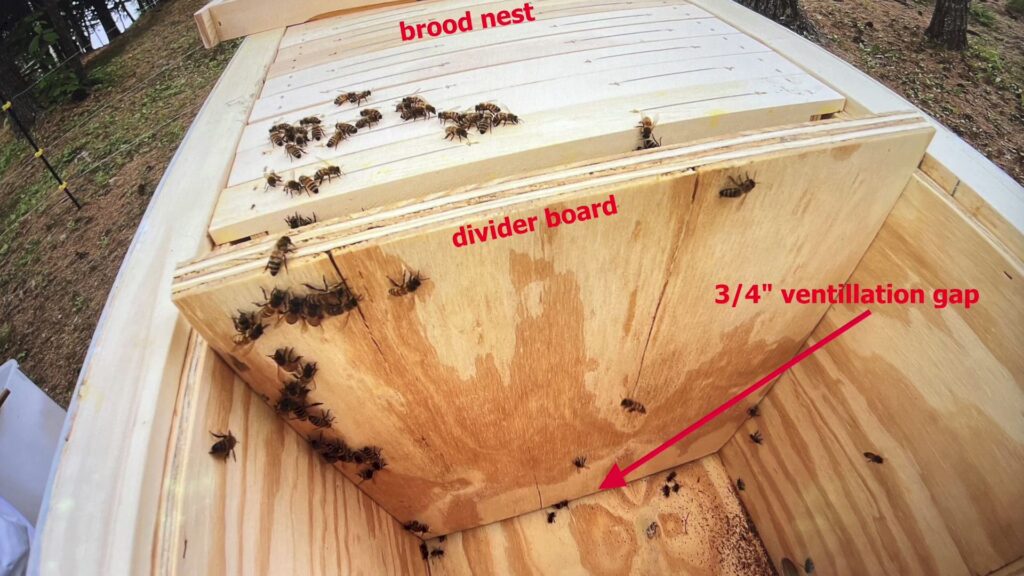
At the heart of a Layens hive is its frame ~16”deep.
This frame was designed to imitate the size of comb found in a typical natural tree hollow beehives.
An individual movable frame is a beekeeper’s equivalent of a single natural honeycomb. Frames make it easy to inspect & manage the beehives without dealing with a tangled-up mess.
Compared to conventional Langstroth 9″ deep frames, Layens 16″ deep frames are much better for wintering: see Math for Overwintering and Working with Layens Hives.
With Layens frames, the overwintering bees stay in a perfectly shaped spherical cluster closer to their honey stores all winter and move upward easier within a single-box horizontal Layens hive as there are no gaps between multiple boxes like in a conventional vertical Langstroth hive.
A fully built Layens frame with honey weighs about 10 lbs. Seven Layens frames is about 40 liters in volume — it’s what the bees naturally look for in a cavity when swarming. 40 liters volume, however, would only be sufficient for overwintering but not for beekeeper to harvest any extra honey.
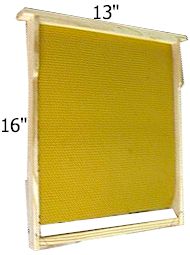
A mid-Summer schematic view of a 20-Frame Layens horizontal hive
At the height of summer horizontal Layens hive is fully filled with frames.
The bees choose frames next to the open entrance to raise brood (darker frames) and frames father from the open entrance they use as honey stores like the bees do in natural tree hollows.
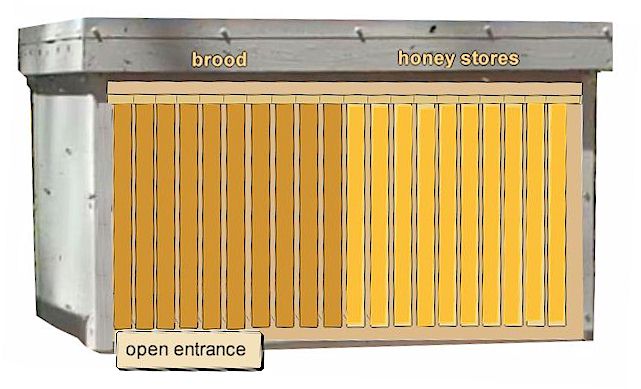
Late Fall-to-early Spring schematic view of a 20-Frame Layens horizontal hive
Between late Fall and early Spring, only about a 1/3 of the space is used and flanked by a divider board – a smaller beehive size like in a natural tree hollow benefits overwintering – it’s cosier and warmer in a smaller space.
Just like in natural tree hollow, 16” deep frames in a horizontal hive represent contiguous honeycombs with no gaps in between.
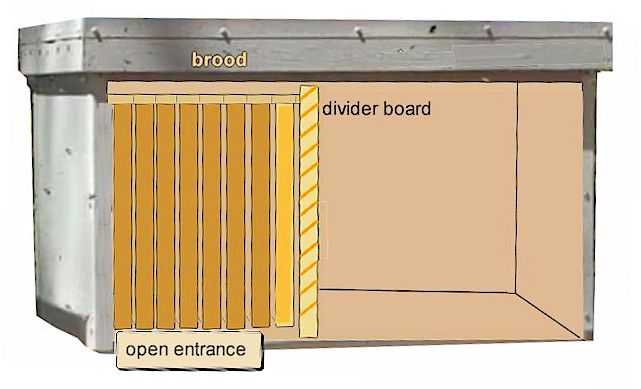
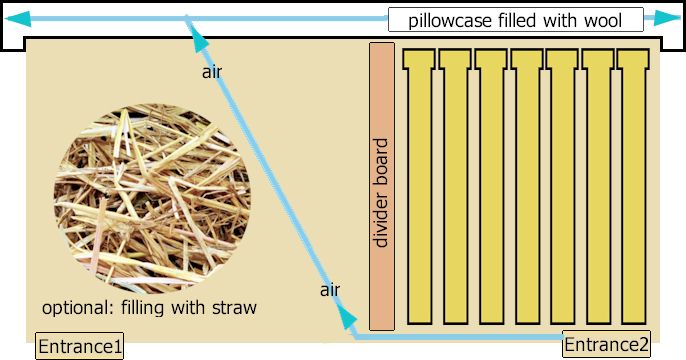
In cold climates insulated Layens hives provide good ventilation and moisture control with the minimal loss of heat. The bees propolize the top frames (that touch in Layens hives) and the divider boards up to the top frames – just where the bees deem it appropriate. We do not interfere with their propolis seal!
For wintering, insulated Layens-style horizontal beehive can provide a delicate balance between insulation, ventilation and moisture control that is appropriate for winters in cold climates. See our Fall Apiary Tasks below.
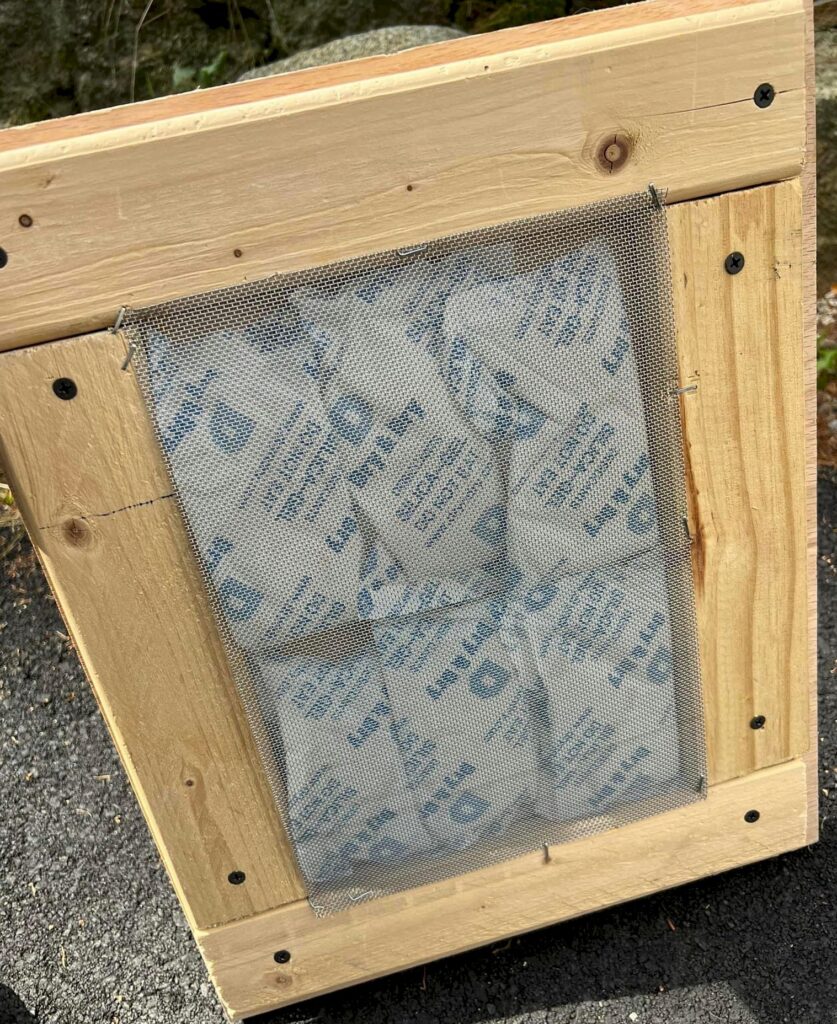
A moisture-control divider board for wintering in Layens hives – food-grade silica gel packs under a stapled metal mesh. ECO plywood and wood.
This is an auxiliary moisture control – the main moisture control is via a natural wool-filled pillow on top of the brood nest.
The metal mesh does not face the bees – faces the opposite side. Also, the bees cannot enter it because of the mesh. Six 100g silica gel packs per 1 divider board. 2 such divider boards for a 20-frame layens hive.
When closing up for winter (around mid-October in Zone 5), any honey outside of the brood nest can be considered surplus, so if there are any honeycombs, all of them except the last one can be taken: one should be left for Spring emergencies.
The divider board should have a 1/2″ to 3/4″ ventillation gap under it. The roof of the Layens hive has a 2″ air pocket between the frames and the roof to accommodate the insulation. The roof also has screen openings on both ends to allow moisture to escape.
As far as which brood frames to leave (and, more importantly, which frames not to leave) for overwintering in horizontal hives, we follow a calculation provided by F. Lazutin in “Keeping Bees with a Smile”: during cold winters the bees on average move upwards on the same frame by 1mm every 24 hours consuming the honey.
With the duration of our average Zone 5 Maine winters, 1mm per 24 hours roughly corresponds to frames with honey band of greater than 5 inches.
So we will not leave in the beehive any frame that has less than 5 in of honey band on both sides because the bees can starve on that frame, reaching its top in cold winters while unable to move to a different frame!
In addition to brood frames with > 5 in honey band, for Springtime emergencies we are also leaving a full honey frame.
So any frames with less than 5 in honey bands on top in my zone 5 are only great for …harvesting. This is our harvesting video.
Two primary tasks for Spring : Expanding the brood nest & Splitting the colony
